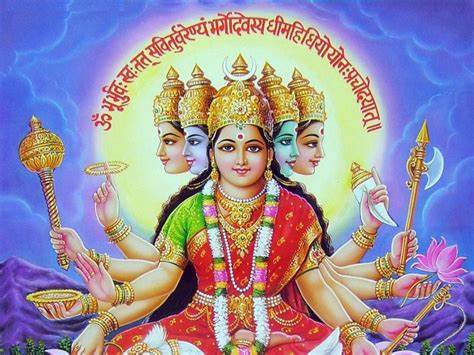
The Gayatri mantra is one of the most revered and widely recited hymns in Hinduism. It is a highly potent and sacred mantra found in the Rigveda, one of the oldest and most authoritative scriptures of Hinduism. The mantra is dedicated to Goddess Gayatri, who is considered the personification of the divine Gayatri mantra.
Here is the Gayatri mantra along with its English translation:
Sanskrit:
ॐ भूर्भुवः स्वः
तत्सवितुर्वरेण्यं
भर्गो देवस्य धीमहि
धियो यो नः प्रचोदयात्॥Transliteration:
Om Bhur Bhuvah Svah
Tat Savitur Varenyam
Bhargo Devasya Dhimahi
Dhiyo Yo Nah PrachodayatKey aspects of the Gayatri mantra:
- Universal Prayer: The Gayatri mantra is considered a universal prayer that can be chanted by people of all religious backgrounds and is not confined to any specific deity or sect.
- Invocation of Light: The mantra is an invocation of the divine light and is often seen as a prayer for spiritual awakening, clarity of thought, and guidance.
- Symbolism: The mantra is rich in symbolism, representing the divine principles manifest in the sun, the ultimate source of light and energy.
- Meditative Practice: Reciting the Gayatri mantra is considered a meditative practice, and it is often chanted during daily rituals, ceremonies, and personal meditation.
- Vedic Tradition: The mantra is part of the Vedic tradition and is recited in the morning during the daily Sandhyavandanam ritual by Brahmins.
- Gayatri Devi: In some traditions, Gayatri is personified as a goddess with five heads, each representing the five elements and the five senses.
- Mantra of Enlightenment: The Gayatri mantra is often referred to as the “Mantra of Enlightenment” and is believed to have the power to dispel ignorance and lead to spiritual awakening.
Devotees believe that chanting the Gayatri mantra with devotion and understanding can bring about spiritual transformation, mental clarity, and inner peace. It is a powerful tool for self-realization and the pursuit of higher knowledge.
Chanting the Gayatri Mantra
There are three specific times in a day when the Gayatri Mantra should be chanted. The three times of a day is also known as Sandhyakal. The first time is before sunrise. The mantra should then be chanted till the sun rises. The second time to chant this mantra in the day is afternoon time. And the third time to chant Gayatri Mantra is before sun set till the sun sets. Apart from these timings, if someone wishes to chant this mantra, he/she should do it silently and at calm from mind. This mantra should not be chanted with loud voice.
There is a huge misconception that women shouldn’t be allowed to recite the Gayatri mantra as it affects their biological cycle. There is no truth in that statement. No Vedic knowledge is barred to any human on the basis of caste, creed or gender. Women have been given an equal spiritual status since times early and anything that puts them down today is all man-made. Before the eyes of god , we are all one.
There is another speculation about the Gayatri mantra. It has to be learnt via a proper guru. The Vedas are not for the lay man. Obviously the Vedas demand a certain respect and disciplinary code, it is always good to understand Vedas from knowledgeable persons. But in absence of them, Ishwar is the ultimate guru and presence of any agent between soul and Ishwar is completely unnecessary.
“Even fools, criminals and men with unstable minds are able to attain enlightenment by the power of Gayatri. When that is so, then the worship of Gayatri by the firm and pure minded persons will surely lead them to self knowledge and self-realization.”
— Sage Vashishtha
There is a theory in thermodynamics which explains why perpetual machines do not work – The process of energy conversion is not enough to give any significant output. This can be overcome by focusing the energy in eliminating these inefficiencies. Similarly if human beings put their effort towards god, we might receive his blessings more. After a point the person attains salvation. The more we direct our attention to the study of source of our knowledge – the Vedas – more the bliss we shall obtain for humanity.
Benefits of Chanting the Gayatri Mantra
These are some of the outcomes of the Gayatri mantra
- Eradication of fear and ignorance in the minds of the people
- Renewed sense of happiness and fervor
- Prioritizing your work and tasks
- Thinking and planning out of the box. Increased creative capacity.
And above all
5. The ability to appreciate the peacefulness of the immediate surroundings and the world.
Another interesting fact about the Vedas is that they are not prayers for personal wellbeing but for the well being of the society. So the Gayatri mantra also prays for divine blessings for all. This feature of “idanna mama “ which meaning it’s nothing personal is echoed throughout all Vedic mantras.
“Japa of Gayatri brings the same fruit as the recitation of all the four Vedas together with the Angas. It is the Mantra of the Vedas. It destroys sins. It bestows splendid health, beauty, strength, vigor, vitality and magnetic aura in the face (Brahmic effulgence).”
— Swami Sivananda
The Gayatri mantra should not be ignored as religious mantras. The pretext of this mantra is completely scientific and is required for all human beings to connect with the divine and rejuvenate themselves.

